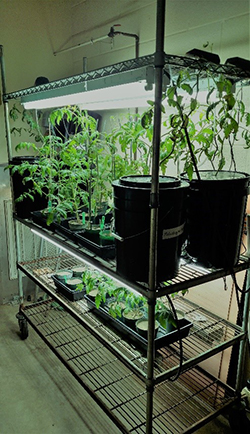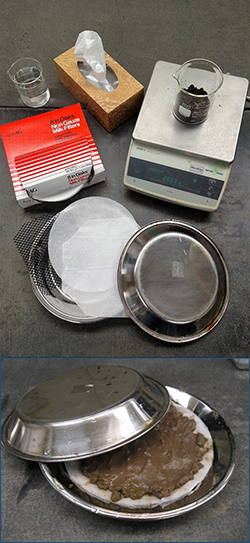Introduction
The purpose of this note is to provide a method for instructors to generate RKN J2s for classroom activities (such as visualization of J2s under the microscope) and experiments (such as host response tests, e.g. the North Carolina Differential Host-Range test (Hartman and Sasser 1985)). This system has utility for achieving classroom teaching objectives because it produces large quantities of single nematode species cultures free of debris. Students learning to identify plant-parasitic nematodes by examination of morphological characteristics will benefit from studying cultures that lack the impediment of non-plant parasitic nematode species or soil fragments. This exercise is best suited to introductory plant pathology and nematology undergraduate and graduate courses.

Fig. 1. Hydroponics unit assembly and view of interior of the bucket with root mass and bubbler stone for rearing of Northern root-knot nematode (Meloidogyne hapla) second stage juveniles.
|
RKN is one of the most important and common plant-parasitic nematodes worldwide, frequently resulting in substantial reductions in crop yield and quality (Mitkowski and Abawi 2003; Jones et al. 2013). Many RKN species have a broad host range, infecting many field, vegetable, fruit, and ornamental crops. Achieving sufficient control in the field through crop rotation can be difficult because of their broad host range (Mitkowski and Abawi 2003).
RKN species are well suited to rearing in a hydroponics system because adult females maintain a fixed feeding site, the eggs are released outside the roots, and the structure of the roots is maintained during infestation. This allows the roots to survive intact while in the hydroponics system, thus supporting the nematodes' obligate biotrophic lifecycle. RKN molt to the first stage juvenile (J1) within the egg and hatch as J2s, which is the motile, infectious stage of the life cycle (Jones et al. 2013). The J2s find and penetrate the roots and establish a feeding site (Bridge and Starr 2007; Jones et al. 2013). Males are usually only present in low numbers and develop more frequently under unfavorable environmental conditions (e.g. low oxygen, poor host, elevated temperature, or high populations of J2s) (Eisenback and Triantaphyllou 1991). Hatching is dependent upon moisture, temperature, and availability of oxygen and is not initiated by specific root exudates (Wallace 1968; Mitkowski and Abawi 2003; Jones et al. 2013). The complete life cycle (egg to egg) for many RKN typically takes 4 to 5 weeks (Mitkowski and Abawi 2003; Bridge and Starr 2007).
Hydroponics System Establishment

Fig. 2. Example of a lighting rack with four hydroponics units and additional infected tomato plants for rearing of Northern root-knot nematode (Meloidogyne hapla) second stage juveniles.
|
Each hydroponics unit (Fig. 1) consists of an 18.9 L food-grade plastic bucket with a fitted lid. Two holes are made in the lid, one in the center approximately 2.5 cm in diameter through which the stem of a tomato plant is placed, and a second 3 cm from the perimeter of the lid, approximately 1 cm in diameter, through which air tubing is threaded. The bucket and lid are painted with black spray-paint to reduce the amount of light entering the reservoir water and restrict algal growth. An aquarium air pump (e.g. 18.9 to 56.8 L dual outlet Aqua Culture aquarium pump; Walmart Inc., Bentonville, AR) is attached to a 10.2 cm long bubbling stone with standard diameter aquarium air tubing. The bubbling stone is placed at the base of the bucket and the aquarium pump operates continuously (24 h). The bucket is filled with approximately 13 L of distilled water and amended with 30 ml of liquid fertilizer (e.g. Grow Big Hydroponic; Fox Farm Soil & Fertilizer Company, Arcata, CA). A variable amount of 0.5 M calcium hydroxide may be added to maintain the pH of the reservoir water between 6.0 and 6.5. The hydroponics unit is placed on a light rack with a 14 h photoperiod at room temperature (Fig. 2).
Seed tomato plants (cv. 'Rutgers') on sterilized fine grain beach sand (autoclaved 20 min sterilization time, 5 min dry time). The 'Rutgers' cultivar is preferred as it is highly susceptible to RKN and hence a suitable propagation host. If you cannot sterilize the sand, consider purchasing sifted sand from a landscape supplier. Leave sand to cool on the benchtop, then portion into 10 smaller sized plastic pots (e.g. 10.2 cm diameter) and moisten with distilled water. Place three seeds approximately 1.5 cm deep in each pot and lightly cover with the sterilized sand. Thin to one plant per pot when they have produced the first set of true leaves. Water plants with a complete fertilizer (e.g. Miracle-Gro All Purpose Plant Food; Scotts Miracle-Gro Company, Marysville, OH) at the manufacturer's recommended rate for the first four weeks after emergence, as the sand does not provide sufficient nutrients for optimal plant growth.

Fig. 3. Modified Whitehead tray assembly used for extraction of Northern root-knot nematodes (Meloidogyne hapla) second stage juveniles from colonies maintained on tomato (cv. 'Rutgers') in soil in the greenhouse, for establishment of the hydroponics system.
|
Begin inoculating plants with
M. hapla J2s approximately 35 days after planting (DAP), or when the plants are approximately 12 to 15 cm tall.
M. hapla J2s may be extracted from colonies maintained on tomatoes (cv. 'Rutgers') or other susceptible hosts in the greenhouse through a modified Whitehead tray method (Whitehead and Hemming 1965) (Fig. 3). Briefly, inside a round pastry baking tin, nest a mesh support (e.g. plastic “gutter guard" cut into approximately 15 cm length pieces), a milk filter (KenAG; Ashland, OH), and a single-ply facial tissue (e.g. Kleenex; Kimberly-Clark Corp., Irving, TX). On top of the assembly, place an aliquot (approx. 200 g) of infested soil and finely chopped root matter. Add approximately 300 ml of distilled water to the baking tin and allow the water to gently moisten the soil through the mesh support, filter, and facial tissue. Place another pastry baking tin upside down over the assembly to cover and prevent loss of water by evaporation. Incubate the assembly at room temperature for 48 h. The nematodes will migrate from the soil through the tissue and into the water. Following the incubation period, discard the soil and collect the water containing the nematodes. Water the nematode suspension solution collected by the modified Whitehead tray or other methods into the root zone of the tomatoes. Repeat inoculations using the same technique every three days for at least 30 days.
After the inoculation period, gently remove plants from their pots and wash the sand away with a gentle stream of cool tap water. Take care to support the root mass so that it does not tear away from the plant. Place the tomato into the hydroponics buckets (one per bucket). Affix plants to the lighting rack with wire ties or garden string to support the foliage and keep the plant from slipping down. Adjust the reservoir water level as needed to ensure the root mass is just covered. Monitor populations of
M. hapla J2s in the reservoir water on a weekly basis by taking a sample from the buckets and confirming presence and evaluating populations under 100× magnification.
Regular Maintenance
Keep the infected tomato plants in the hydroponics buckets for approximately 30 days before replacing with a fresh plant, without changing the reservoir water. Seed new tomato plants (cv. 'Rutgers') every 40 to 50 days to ensure a continuous cycle of plants for inoculation. Begin inoculation of the replacement tomato plants at approximately 30 DAP (or when plants were approximately 12 to 15 cm tall) by watering with reservoir water siphoned from the buckets. Continue inoculations in this way for at least 30 days (up until approximately 60 DAP). However, depending on the population density of nematodes within the hydroponics buckets, inoculation time may need to be extended to ensure establishment of sufficient populations. Following the inoculation period, remove plants from their pots, gently wash the sand away, and place in the hydroponics buckets, as described above.
Rotating new tomato plants through the buckets without replacing the reservoir water for several cycles promotes population increase. Every 4 to 5 months, the system components should be completely disassembled, washed with hot soapy water, reassembled, and filled with fresh distilled water. Bleach should be avoided in this process as residues may negatively impact nematode populations. After filling the buckets and placing the new tomato plants, add 30 ml of liquid fertilizer and a variable amount of 0.5 M calcium hydroxide (to maintain pH of the reservoir between 6.0 and 6.5) to the buckets.
Preparing Inoculum

Fig. 4. Funnel apparatus and materials used for sieving and collection of nematodes from the reservoir water of the hydroponics buckets.
|
Working at a sink area, assemble the collection apparatus (Fig. 4). Place a glass funnel over the desired collection bottle using a ring stand and support. Using a 25 mm mesh sieve held at a 45° angle over the sink, pass several cups of reservoir water through the sieve. Then, holding the sieve near vertical, wash the captured nematodes on the sieve to one side with distilled water. Briefly wash the back of the sieve to assist the retrieval of nematodes that passed halfway through the sieve. Finally, transfer nematodes from the sieve to the collection bottle by turning the sieve slightly over and rinsing into the funnel. Repeat the process until all the water from the hydroponics reservoir passes through the sieve.
Once the nematodes are collected, determine the concentration of nematodes per ml by removing and counting three aliquots of 3 ml each in a nematode counting dish under 400× magnification. This number may be used to calculate the total quantity of inoculum solution required for a specific objective.
Here,
M. hapla was used as a model organism for development of the system, but this hydroponics system would also be suitable for rearing other
Meloidogyne species.
Acknowledgements
Development and use of this hydroponics system methodology was financially supported by the United States Department of Agriculture, National Institute of Food and Agriculture (USDA - NIFA) Education and Literacy Initiative Pre-Doctoral Fellowship (award number 2018-67011-28072), and the USDA-NIFA Hatch project NYG-625424.
References
Bridge, J., and Starr, J. L. 2007. Plant Nematodes of Agricultural Importance: A Colour Handbook. London: CRC Press.
Eisenback, J. D., and Triantaphyllou, H. H. 1991. Root-Knot Nematodes:
Meloidogyne Species and Races. In Manual of Agricultural Nematology. Ed. W. R. Nickle. Pp. 191-274. New York: Marcell Dekker.
Hartman, K. M., and Sasser, J. N. 1985. Identification of
Meloidogyne species by differential host test and perineal pattern morphology. In An Advanced Treatise on
Meloidogyne: Vol. II Methodology. Eds. K. R. Barker, C. C. Carter, and J. N. Sasser. Pp. 69-77. North Carolina State University Graphics, Raleigh.
Jones, J. T., Haegeman, A., Danchin, E. G. J., Gaur, H. S., Helder, J., Jones, M. G. K., Kikuchi, T., Manzanilla-López, R., Palomares-Rius, J. E., Wesemael, W. M. L., and Perry, R. N. 2013. Top 10 plant-parasitic nematodes in molecular plant pathology. Mol. Plant Pathol. 14:946–961.
Lambert, K. N., Tedford, E. C., Caswell, E. P., and Williamson, V. M. 1992. A system for continuous production of root-knot nematode juveniles in hydroponic culture. Phytopathology 82:512-515.
Mitkowski, N. A., and Abawi, G. S. 2003. Root-knot nematodes. Plant Health Instr. DOI: 10.1094/PHI-I-2003-0917-01
Wallace, H. R. 1968. The influence of aeration on survival and hatch of
Meloidogyne javanica. Nematologica 14:223-230.
Whitehead, A. G., and Hemming, J. R. 1965. A comparison of some quantitative methods of extracting small vermiform nematodes from soil. Ann. Appl. Biol. 55:25–38.
